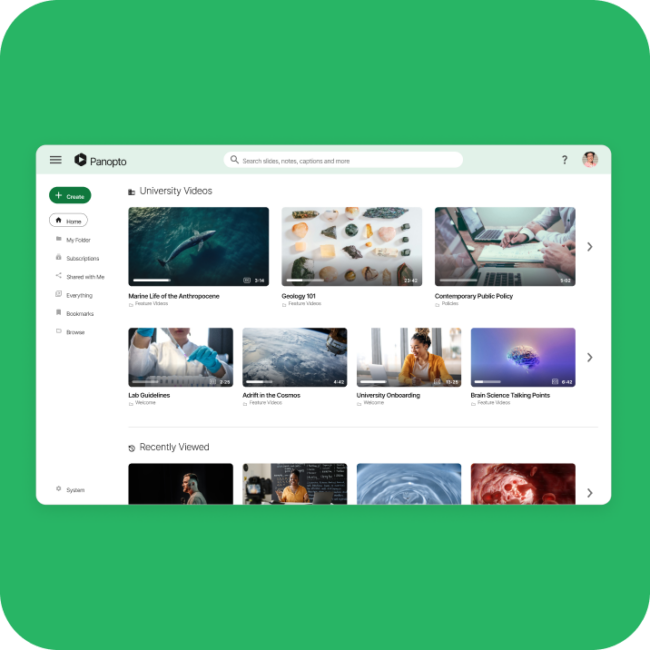- Training
How to Create Competency-Based Training and Learning Programs with Video

Organizations today need training programs that deliver measurable results and directly improve employee performance. Competency-based learning and competency-based training focus on building specific skills and behaviors tied to clear outcomes, ensuring employees can effectively apply their knowledge in real-world scenarios.
Incorporating video into competency-based learning programs enhances scalability, engagement, and consistency. Video makes it easier to demonstrate key competencies, showcase real-world examples, and create memorable training experiences. This post will show you how to use video to develop effective competency-based training programs, offering frameworks, principles, and practical steps to get started.
What Is Competency-Based Training and Learning?
Competency-based training and competency-based learning are structured approaches designed to help individuals develop specific skills and behaviors that align with measurable performance outcomes. Unlike traditional learning models, which often focus on completing a set curriculum within a fixed timeframe, competency-based learning programs prioritize mastering specific competencies at an individualized pace.
At its core, the competency-based training model is built around clear expectations, where employees are assessed based on their ability to demonstrate competencies in real-world scenarios. These programs often incorporate competency framework samples, which outline the skills and knowledge required for success in a particular role. This ensures that training is practical, relevant, and directly tied to workplace needs.
Key principles of competency-based training include flexibility, skill application, and outcome measurement. For example, in higher education, a competency-based learning program might involve teaching students to demonstrate mastery of critical thinking skills through project-based assessments. Similarly, in the workplace, a competency-based training example could include training employees to effectively manage team projects using specific collaboration tools, ensuring both productivity and consistency across departments.
Focusing on competency in the workplace bridges the gap between theoretical knowledge and practical application, making it a powerful tool for driving employee growth and organizational success. Whether you’re training a small team or rolling out a company-wide program, competency-based training basics provide a scalable framework for building better skills through measurable results.
Why Use Video for Competency-Based Learning Programs?
Video enhances competency-based learning programs by making training scalable, engaging, and consistent. It allows organizations to deliver competency-based training models to large teams efficiently, ensuring every employee receives the same high-quality instruction.
Visual demonstrations of competency-based training examples, such as real-world workplace scenarios, help learners connect theory to practice. Additionally, video improves retention by using dynamic visuals and role-play to engage learners while maintaining consistency in delivering a competency framework sample across the workforce. Video is a powerful tool for modernizing training and achieving measurable outcomes.
Steps to Create a Competency-Based Training Program with Video
Building an effective competency-based training program with video involves careful planning and execution. Follow these steps to ensure success:
1. Define Competency Frameworks
Start by identifying the skills and behaviors employees need to succeed. Develop a clear competency framework sample that outlines specific competencies for each role. This framework will serve as the foundation for your training program.
2. Design Video Training Content
Outline the learning objectives and structure your program around measurable outcomes. Incorporate competency-based training principles to ensure the content aligns with real-world applications. Identify competency-based training examples to guide the creation of relatable and actionable content.
3. Develop Video Content
Create engaging videos that demonstrate competencies in action. Use role-play scenarios, tutorials, and expert interviews to illustrate competency in the workplace. Keep videos concise and focused to maximize engagement and retention.
4. Deliver Video Training Modules
Host and distribute your videos through a platform like Panopto. Allow employees to access the competency-based learning program at their own pace, ensuring flexibility and accessibility for diverse learning needs.
5. Assess Competency Development
Incorporate assessments into your program to evaluate how well employees are mastering the skills outlined in the competency framework sample. Use video-based assessments to measure progress and identify areas for improvement.
By following these steps, you can create a scalable, engaging, and effective competency-based training program that leverages the power of video to drive measurable results.
Best Practices for Video-Based Competency-Based Training Programs
To ensure the success of your competency-based training program, it’s essential to combine clear objectives with engaging, accessible content. Here are some best practices to guide your efforts:
- Align Training with Real-World Needs: Focus on developing practical, actionable skills that employees can immediately apply in their roles. Tie competencies to measurable outcomes that align with organizational goals, ensuring relevance and impact.
- Use Engaging Video Content: Leverage video to bring competencies to life. Dynamic, relatable scenarios—such as role-plays or real-world demonstrations—help employees visualize how skills are applied in the workplace, improving understanding and retention.
- Incorporate Feedback and Analytics: Use learner feedback and performance metrics to refine your program over time. Regularly updating content based on analytics ensures that your training remains effective and aligned with evolving competency requirements.
- Ensure Accessibility: Make your training content available on-demand so employees can learn at their own pace. Enhance inclusivity by incorporating captions, subtitles, or translations to meet the needs of diverse learners.
By combining engaging video content with measurable goals and continuously refining your approach based on data, you can create competency-based training programs that effectively address organizational needs and drive meaningful results.
Elevate Employee Performance with Competency-Based Training Programs
Implementing competency-based learning programs with video is a powerful way to build a skilled, confident workforce. By focusing on measurable outcomes and leveraging engaging video content, organizations can create scalable, impactful training programs that address real-world needs.
From defining clear competencies to delivering consistent, on-demand video modules, this approach ensures employees gain the practical skills they need to excel. Ready to revolutionize your training strategy? Schedule a Panopto demo today and embrace the power of video and competency-based training to drive results and elevate employee performance.
Latest News
-

- Sales
How to Make Sales Presentation Videos With AI
A sales presentation can make or break a deal—yet too many sales teams still rely on outdated slides and monotonous pitches. Video content accounts for over 82% of consumer internet traffic. We live in a digital-first world where video is the key to capturing attention and driving engagement. But creating a polished, persuasive sales video…
How to Make Sales Presentation Videos With AI
-

- Active Learning
Why Every Business Needs an Upskilling Strategy (And How to Build One)
A strong upskilling strategy is no longer optional. It’s essential for keeping pace with rapid technological advancements and shifting market demands. As AI and automation reshape industries, companies must ensure their employees continuously develop new skills to stay competitive. But upskilling alone isn’t enough. Reskilling is equally critical for preparing workers to transition into entirely…
Why Every Business Needs an Upskilling Strategy (And How to Build One)
-

- Training
How to Turn Policy Updates into Just-in-Time Training Videos
In today’s fast-paced workplaces—whether on the manufacturing floor or the trading floor—keeping employees updated on policy changes is critical. But let’s face it: expecting your workforce to sift through long policy documents is unrealistic, especially when time is tight. That’s where the power of just-in-time training videos comes in. This article explores how you can…
How to Turn Policy Updates into Just-in-Time Training Videos



